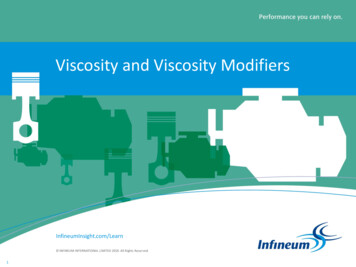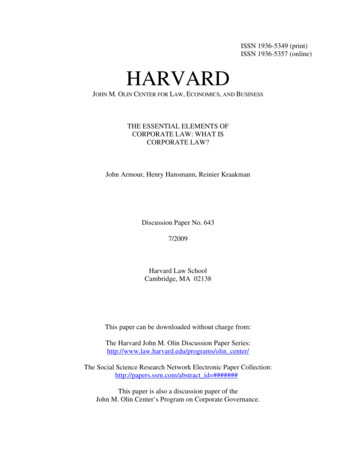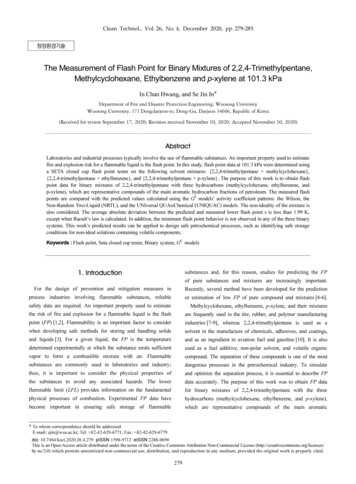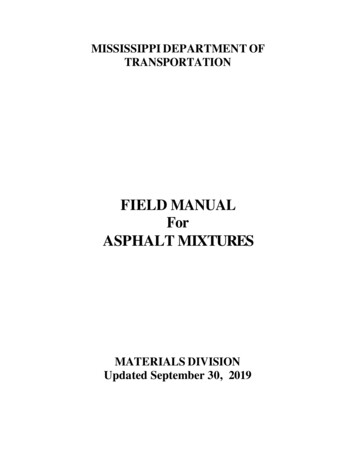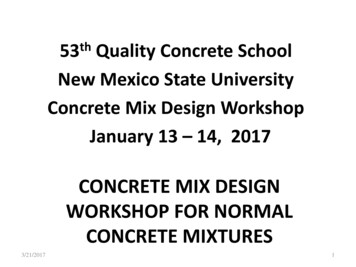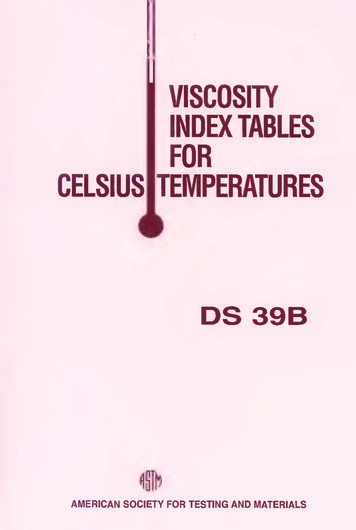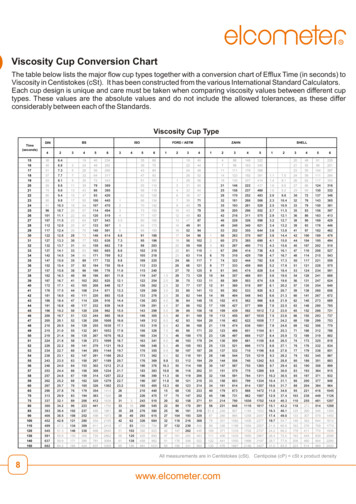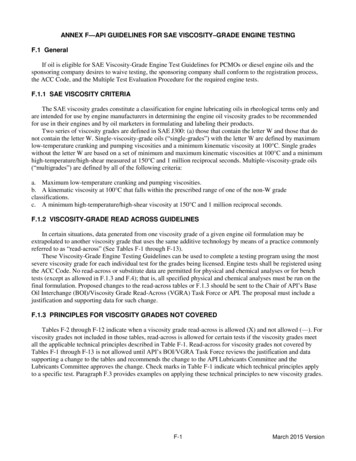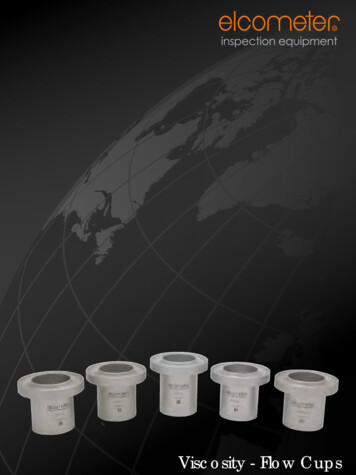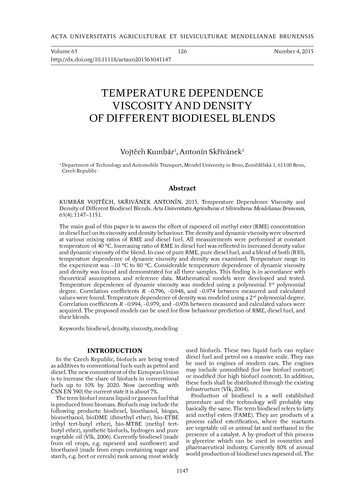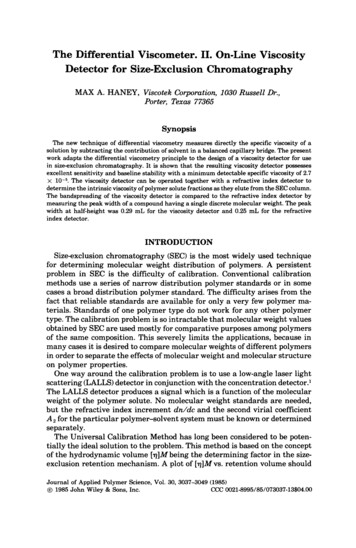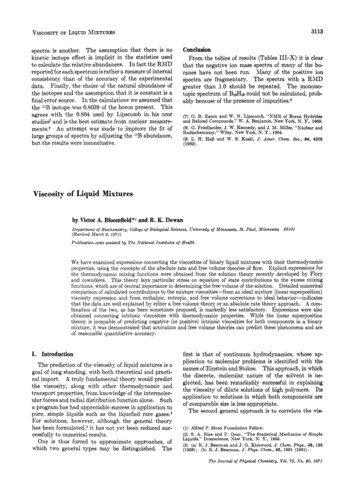
Transcription
3113VISCOSITYOF LIQUIDMIXTURESspectra is another. The assumption that there is nokinetic isotope effect is implicit in the statistics usedto calculate the relative abundances. I n fact the RMDreported for eachspectrumisrather a measure of internalconsistency than of the accuracy of the experimentaldata. Finally, the choice of the natural abundance ofthe isotopes and the assumption that it is constant is afinal error source. In the calculations we assumed thatthe llB isotope was 0.8039 of the boron present. Thisagrees with the 0.804 used by Lipscomb in his nmrstudies’ and is the best estimate from nuclear measurementsG8 An attempt was made to improve the fit oflarge groups of spectra by adjusting the llB abundance,but the results were inconclusive.ConclusionFrom the tables of results (Tables III-X) it is clearthat the negative ion mass spectra of many of the boranes have not been run. Many of the positive ionspectra are fragmentary. The spectra with a RMDgreater than 1.0 should be repeated. The monoisotopic spectrum of BwH-Bcould not be calculated, probably because of the presence of impuritie . (7) G. R . Eaton and W. N . Lipscomb, “NMR of Boron Hydridesand Related Compounds,” W. A. Benjamin, New York, N. Y., 1969.(8) G. Friedlander, J. W. Kennedy, and J. M. Miller, “Nuclear andRadiochemistry,” Wiley, New York, N . Y., 1964.(9) L. H. Hall and W. S. Koski, J. Amer. Chem. SOC.,84, 4206(1962).Viscosity of Liquid Mixturesby Victor A. Bloomfield*l and R. K. DewanDepartment of Biochemistry, College of Biological Sciences, University of Minnesota, St. Paul, Minnesota 66101(Received March 2, 1971)Publication costs assisted by The National Institutes of HealthWe have examined expressions connecting the vjscosities of binary liquid mixtures with their thermodynamicproperties, using the concepts of the absolute rate and free volume theories of flow. Explicit expressions forthe thermodynamic mixing functions were obtained from the solution theory recently developed by Floryand coworkers. This theory lays particular stress on equation of state contributions to the excess mixingfunctions, which are of central importance in determining the free volume of the solution. Detailed numericalcomparison of calculated contributions to the mixture viscosities-from an ideal mixture (linear superposition)viscosity expression and from enthalpic, entropic, and free volume corrections to ideal behavior-indicatesthat the data are well explained by either a free volume theory or an absolute rate theory approach. A combination of the two, as has been sometimes proposed, is markedly less satisfactory. Expressions were alsoobtained connecting intrinsic viscosities with thermodynamic properties. While the linear superpositiontheory is incapable of predicting negative (or positive) intrinsic viscosities for both components in a binarymixture, it was demonstrated that activation and free volume theories can predict these phenomena and areof reasonable quantitative accuracy.I. IntroductionThe prediction of the viscosity of liquid mixtures is agoal of long standing, with both theoretical and practical import. A truly fundamental theory would predictthe viscosity, along with other thermodynamic andtransport properties, from knowledge of the intermolecular forces and radial distribution function alone. Sucha program has had appreciable success in application topure, simple liquids such as the liquefied rare gases.2For solutions, however, although the general theoryhas been f r m u l a t e dit, has not yet been reduced successfully to numerical results.One is thus forced to approximate approaches, ofwhich two general types may be distinguished. Thefirst is that of continuum hydrodynamics, whose application to molecular problems is identified with thenames of Einstein and Stokes. This approach, in whichthe discrete, molecular nature of the solvent is neglected, has been remarkably successful in explainingthe viscosity of dilute solutions of high polymers. Itsapplication to solutions in which both components areof comparable size is less appropriate.The second general approach is t o correlate the vis(1) Alfred P. Sloan Foundation Fellow.(2) S. A. Rice and P. Gray, “The Statistical Mechanics of SimpleLiquids,” Interscience, New York, N . Y., 1966.(3) (a) R. J. Bearman and J. G. Kirkwood, J . Chem. Phys., 2 8 , 136(1958); (b) R. J. Bearman, J . Phys. Chem., 65, 1961 (1961).The Journal of Physical Chemistry, Vot. 76, No. 20, 1071
VICTORA. BLOOMFIELDAND R. E(. DEWAN3114cosity of the mixture with the properties of the purecomppnents and with thermodynamic parameterscharacteristic of the interaction between components.I n simplest form, the interactions may be neglected andsimple additive relations assumed. One such relationcommonly used isIn 7 X1 In 71 Xz In92(1)where 9 is the viscosity of the solution, and XI, X z , ql,and 7z are the mole fractions and viscosities of the twocomponents in a binary mixture. However, it will benoted that this equation, and other similar ones, predictmonotonic increases or decreases of Viscosity with composition. Such monotonicity is often not observed inpractice. It is therefore generally necessaiy to take explicit account of interactions.There are two major semiempirical theories of liquidviscosity. The first is the absolute reaction rate theoryof Eyring and coworl ers. This relates the viscosity tothe free energy needed for a molecule t o overcome theattractive force field of its neighbors, so that it can jump(flow) to a new equilibrium position. Thus the deviation of the mixture viscosity from eq 1 should be related to the free energy-more precisely, the excess freeenergy-ofm i i n g . The second semiempiricalwhich relates thetheory is the free volumeviscosity to the probability of occurrence of an emptyneighboring site into which a molecule can jump. Thisprobability is exponentially related to the free volume ofthe liquid, so deviations from eq 1 can be attributed tovariations in the free volume of the solution.Macedo and LitovitzlO have argued that neither ofthese theories is entirely adequate in its own right, andthat better results for pure liquids are obtained by combining them. Thus the probability for viscous flow istaken as the product of the probabilities of acquiringsufficient activation energy and of the occurrence of anempty site. It has been shown” that the assumptionthat these two probabilities are independent, and maytherefore be multiplied, is incorrect for a one-dimensional liquid. While this conclusion also presumablyholds in three dimensions, it will be of interest to investigate the consequences of the assumption of independentprobabilities for viscosities of liquid mixtures in thetreatment that follows.The free energy and free volume data required inthese viscosity theories may occasionally be availabledirectly from experiment. This is often not the case,however, particularly for the free volume, whose operational definition is in any event somewhat ambiguous. loWe have therefore preferred to obtain the thermodynamic parameters from a statistical thermodynamictheory of liquid mixtures proposed by Flory and coworkers. 12-14 This theory, which bears some similarities to the corresponding states theory of Prigogine andcolleague , treats the properties of mixtures in terms ofreduced properties of the pure components and a singleThe Journal of Physical Chemistry, Vol. 7 6 , No. BO, 1971interaction parameter. It thus has a minimum of adjustable parameters. The theory is applicable to mixtures of molecules of different sizes and lays particularstress on equation of state contributions to the thermodynamic excess functions, which are of central importance in determining the free volume of the solution.Use of theoretical expressions for the thermodynamicproperties of mixtures has the further advantage that anequation for the intrinsic viscosity, or the rate of changeof viscosity with concentration at infinite dilution of onecomponent, can be explicitly formulated by expandingthe thermodynamic functions in a power series in concentration and keeping only the first nontrivial terms.In this paper we shall first write down an equation forthe viscosity of a liquid mixture in terms of the quantities which might contribute to it: the viscosities of thepure components and the changes in enthalpy, entropy,and free volume upon mixing. We then use the Florylatheory to obtain explicit expressions for these contributions in terms of properties of the pure components andan interaction parameter. The results are numericallycompared with experimental data on the viscosities ofseveral binary liquid mixtures over the whole range ofrelative composition. We then derive an equation forthe intrinsic viscosity and apply it to these mixtures.I n the following paper we compare the “thermodynamic” intrinsic viscosity theory developed here with acontinuum hydrodynamic treatment of the intrinsic viscosity of chain molecules, in calculating the intrinsicviscosities of a homologous series of n-alkanes.11. Theory of Mixture ViscosityCombining the absolute rate and free volume theoriesof viscosity, one 0btains4 9 1 for the viscosity of the solution7 A exp[AG*/RT -I- yv*/urI(2)AG* is the activation free energy per mole of solution,R is the gas constant, and T i s the absolute temperature.v* is the empty volume which must be available for amolecular segment jumping to its new site, vf is the free(4) S. Glasstone, K. J. Laidler, and H. Eyring, “The Theory of ItateProcesses,” McGraw-Hill, New York, E.Y., 1941, Chapter 9.(5) W. E. Roseveare, R. E. Powell, and H. Eyring, J . AppZ. Phys.,12, 669 (1941).(6) M. R. V. Krishnan and G. S. Laddha, I n d . Eng. Chem., Fundam.,7, 324 (1968).(7) A. K. Doolittle, J . AppZ. Phys., 22, 1471 (1951); 23, 236 (1952).(8) M.L. Williams, R. F. Landel, and J . D. Ferry, J . A m e r . Chem.Soc., 77, 3701 (1955).(9) M. H. Cohen and D. Turnbull, J . Chem. Phys., 31, 1164 (1959).(10) P. B. Macedo and T. A. Litovitz, ibid., 42, 245 (1965).(11) V. A. Bloomfield, ibid., 52, 2781 (1970).(12) P . J. Flory, E. A. Orwoll, and A. Vrij, J . A m e r . Chem. SOC.,86,3507, 3515 (1964).(13) P. J. Flory, ibid., 87, 1833 (1965).(14) A. Abe and P. J. Flory, ibid., 87, 1838 (1965).(15) I. Prigogine, “The Molecular Theory of Solutions,” NorthHolland Publishing Co., Amsterdam, 1957.
VISCOSITYOF LIQUIDMIXTURES3115volume per segment in the solution, and Y is a factor oforder unity. As will be seen below, v* is also identifiedwith the hard-core volume of a segment, and it is therefore implicitly assumed in eq 2 that viscous flow occursby segmental motion rather than by motion of wholemolecules. An equation of the same form holds for thepure componentst i A exp[AGi*/RT yv*/vfl](i 1, 2) (3)where the subscript labels the property of pure component i. (It should be noted that Macedo and Litovitz'o write AE*, the energy of activation, for AG*in these equations. Use of AG* seems more consistentwith the fundamental assumptions of absolute ratetheory .)we now assumeFollowing Roseveare, et XZAGZ' - aAGRAG* X,AGl*(4)where AGR, the residual free energy,13is closely relatedto the excess free energy of mixing as discussed below.a is a constant of order unity. I n the absence of independent knowledge of the values or significance ofa arid y, we shall henceforth set them both equal tounity.Substitution of eq 4 in eq 2, taking logarithms of theresulting equation and of eq 3, and simple manipulation then yieldsIn q X1 In 71 X z In9s-AGR(if ;;- v*----RT"2)Vf2(5)The residual free energy of mixing can, in turn, bebroken down into enthalpy and entropy contributionsAGR AHbr - TASR(6)AHMis the enthalpy of mixing per mole of solution.ASR is the residual entropy per mole;13 that is, the entropy of mixing minus the combinatorial entropy. Theresidual entropy diff ers from the conventionally definedexcess entropy of mixing in that, the combinatorial entropy is not necessarily computed according to the idealmixing law for molecules of the same size.The free volume per segment is defined as the difference between the total volume per segment and thehard-core volumevi v - v*(7)Further, we define a reduced volumeD v/v*(8)Upon substitution of eq 6-8 into eq 5, we obtainIn 7 X I In q 1AH,This equation displays explicitly the various contributions t o the mixture viscosity: the ideal mixture viscosity computed from eq 1, the enthalpy and residualentropy of mixing, and the difference in free volume between solution and pure components.111. Expressions for the Thermodynamic FunctionsI n this section we transcribe from the work of Flory,et uZ.,12-14the pertinent expressions for the thermodynamic quantities needed in eq 9. The reader is referredto the original papers for derivations and detailed discussion.A molecule of type i may be characterized by the number of segments, r i , it contains, and by the number ofcontact sites, Si, per segment. (The definition of a segment is left somewhat vague, since in the final expressions all segment properties occur as ratios. The ratioof the number of segments of two molecules is taken asthe ratio of their hard-core molar volumes Vi*: r l / r z V1*/V2*.)Then the segment fractions are 1--- -and the site fraction of component 2 isOne defines characteristic pressures P1* and Pz* andcharacteristic temperatures T1* and Tz* of the purecomponents. The method for determining Pi*, Ti*,and v* from the specific volume, thermal expansioncoefficient, and isothermal compressibility or thermalpressure coefficient has been presented by Flory,et a1.,12-14who tabulate values of these for a number ofliquids.The reduced temperature of pure component i isPi T/Ti*(12)while the reduced temperature of the mixture isXlz is an interaction parameter with units of pressure,determined from the experimental AHbI a t equimolarconcentrations of components 1 and 2, and tabulatedfor numerous mixtures by Abe and F10ry.l The reduced volume of the mixture is
Theory of Mixture Viscosity Combining the absolute rate and free volume theories of viscosity, one 0btains4 9 1 for the viscosity of the so- lution 7 A exp[AG*/RT -I- yv*/urI (2) AG* is the activation free energy per mole of solution, R is the gas constant, and Tis the absolute temperature.
